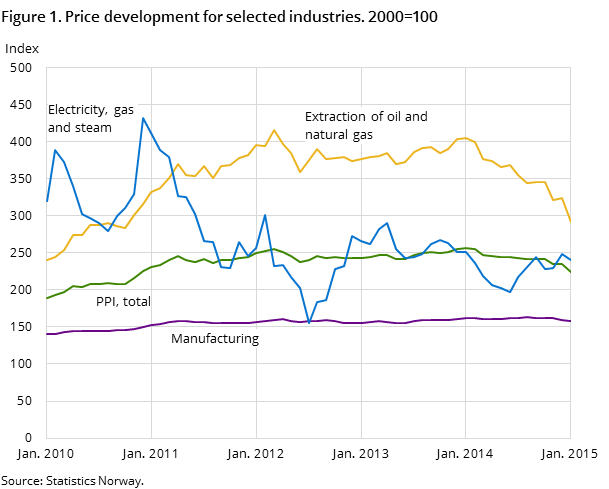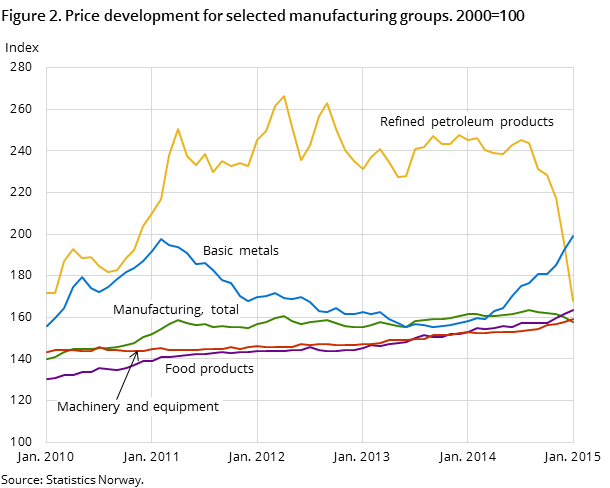Content
Published:
This is an archived release.
Higher prices in manufacturing
The producer price index for oil and gas, manufacturing, mining and electricity (PPI) decreased by 4.5 per cent from December 2014 to January 2015. Lower prices of oil and refined petroleum products caused the decrease in the PPI. Most of the manufacturing groups experienced price increases.
| Per cent | Index | Weights1 | ||
|---|---|---|---|---|
| January 2015 / December 2014 | January 2015 / January 2014 | January 2015 | ||
| 1The weights are updated annually, and are valid for the entire year. | ||||
| Industrial Classification | ||||
| Extraction, mining, manufacturing and electricity | -4.5 | -12.4 | 224.5 | 1 000.0 |
| Extraction and related services | -8.0 | -23.0 | 310.5 | 460.7 |
| Mining and quarrying | 2.0 | 2.0 | 170.2 | 9.0 |
| Manufacturing | -1.5 | -2.4 | 157.6 | 488.6 |
| Food, beverages and tobacco | 1.2 | 6.7 | 162.6 | 106.4 |
| Refined petroleum, chemicals, pharmaceuticals | -9.8 | -23.4 | 173.5 | 125.4 |
| Basic metals | 3.3 | 25.7 | 198.9 | 39.1 |
| Machinery and equipment | 1.0 | 4.2 | 159.3 | 52.8 |
| Electricity, gas and steam | -3.1 | -4.2 | 240.9 | 41.7 |


The PPI was 224.5 (with 2000=100) in January 2015, which is 4.5 per cent lower than in December 2014. The main reason behind the decline in the total index was an almost 10 per cent price decline within ‘extraction of oil and natural gas’. Prices of crude oil (Brent Blend, measured in NOK) dropped by over 16 per cent from December 2014 to January 2015. The decline in the oil prices gave a price decrease of 14 per cent in the manufacturing group ‘refined petroleum products’.
Price increase in Norwegian manufacturing, excl. refined petroleum products
Prices within manufacturing fell by 1.5 per cent from December 2014 to January 2015. The price decline was however caused by the price falls in refined petroleum products. Excluding petroleum products, the index for manufacturing was 1.2 per cent higher in January compared with December.
Inflation in the manufacturing, excluding refined petroleum products, was strong from June 2014 and was mainly due to higher prices on exported products. From June 2014 to January 2015, export prices in manufacturing, excl. petroleum products, increased by over 9 per cent. The weakening of the Norwegian krone (NOK) against the currencies of Norwegian trading partners’ can explain much of the price rise. Inflation in manufactured goods sold to customers in Norway was a great deal weaker than in the export market. In the period June 2014 to January 2015, the prices in manufacturing, excl. petroleum products, for products sold in Norway increased by just over 2 per cent.
Twelve-month rate – PPI down 12.4 per cent
The PPI decreased by 12.4 per cent from January 2014 to January 2015. Lower prices within ‘extraction of oil and natural gas’ of 27.8 per cent and ‘refined petroleum products’ of 31.6 per cent caused the decline in the total. Prices within basic metals and food products dampened the decrease in the PPI.
Updated weights in the PPIOpen and readClose
The PPI is calculated as a weighted average of price changes. In order for the PPI to reflect Norway’s industrial structure, the weights used to compute the price indices are updated every January.
The weights did not change very much from 2014 to 2015. The industry ‘extraction of oil and natural gas’ has lost some of its weights in 2015. Together with ‘mining support service activities’, the ‘extraction and related services’ make up about 46 per cent of the PPI’s weights. The manufacturing industries have gained some weights in 2015 and have about 49 per cent of the PPI’s weights. Manufacturing of food products is now the biggest industry within manufacturing. Manufacturing of refined petroleum products is the second largest manufacturing group. The rest of the weights are divided between electricity production, and mining and quarrying.
See "StatBank" for more details about the weights.
Additional information
Contact
-
Producer price index
E-mail: produsentpris@ssb.no
tel.: (+47) 21 09 40 00
-
Elisabeth Mælum
E-mail: elisabeth.maelum@ssb.no
tel.: (+47) 97 01 28 49
-
Morten Madshus
E-mail: morten.madshus@ssb.no
tel.: (+47) 40 90 26 94
-
Monika Græsli Engebretsen
E-mail: monika.graesli.engebretsen@ssb.no
tel.: (+47) 40 90 23 71
-
Håvard Georg Jensen
E-mail: havard.jensen@ssb.no
tel.: (+47) 40 90 26 86
